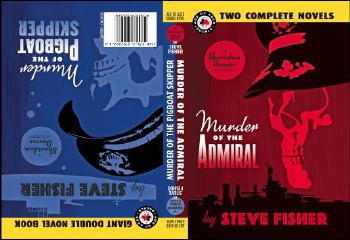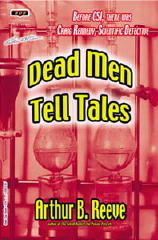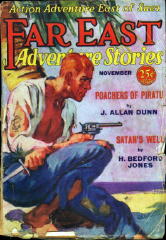August 2008
Monthly Archive
Wed 6 Aug 2008
GEORGE HARMON COXE – One Hour to Kill.
Pyramid R-1186; paperback reprint; 1st printing, May 1965. Alfred A. Knopf, hardcover, September 1963. Book club edition: November 1963.
On the cover it states that this was the author’s 50th mystery, so while I didn’t check that particular figure, I did go to look his record up in Hubin’s Crime Fiction III. It takes a few years to write that many novels, and this one was written when the author was in his early 60s. Coxe went on to write another dozen or so more, averaging a book a year up until he was in his mid-70s. He also wrote for Black Mask and other pulp magazines of the 1930s, moved over to the slicks, and on the side, in his spare time, he did loads of work for radio, TV and the movies.
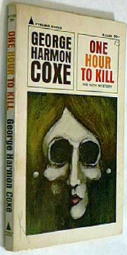
Very well known, and (I’m guessing) almost forgotten today. My own evidence in this regard depends on the other half of what I do when I’m not reading mysteries, and that’s selling them, and I’m sorry to say that George Harmon Coxe is not a big seller. Not a poor seller, I hasten to add, but well below average, and not proportional to his output as an author.
When I was a member of the Dollar Mystery Guild in the mid-to-late 50s, I devoured his books, but mostly the ones with either of the two Boston newspaper photographers, Flashgun Casey or Kent Murdock. I couldn’t tell you why for sure, but I think the lure of a couple of guys who knew their way around a tough metropolitan offered a considerable amount of appeal to a young boy growing up in upstate Michigan.
I didn’t care for his other mysteries very much, though, taking place primarily in the islands of the Caribbean, of which this is a prime example, and in Trinidad, to be precise. Too foreign, to me, I think, at the time.
In any case, to get on with the story, Dave Wallace is having marital problems. He has a new love in his life, but he also has a wife who’s just reneged on a divorce and has come down to move back in. (She also one of the most unpleasant women I come across in quite a bit of reading, if I may offer a brief aside.)
When she’s murdered, as it quite evident she will be within the first two pages of meeting her, Wallace knows he’s the obvious first person the police will suspect, and he decides he has to keep two jumps ahead of them to clear himself, concealing evidence, picking up clues, and generally muddying up the trail. All pretty much the wrong decisions to make — the native policemen are not dummies — but then again, if he didn’t, we probably wouldn’t have a story.
And as it turns out, it’s through his efforts that the crime is solved — a fair-play story of detection — so fair, in fact, that when the truth is revealed, you can see where Coxe practically gave the game completely away, if you were paying attention, and as usual, my mind was somewhere else at the time.

Some of the ways that Wallace gets the information that helps him solve the mystery he finds himself in are artificially and/or awkwardly constructed, though. (I’m not sure which.) Here’s a bit of what I mean:
On page 94 Wallace is talking to someone who says, “There was one other thing, now that I think of it.” This is someone who is on Wallace’s side and eventually ends up confiding in him that (a) he was eavesdropping on the dead woman before she died, (b) overheard the tail end of a crucial telephone conversation, (c) saw another car drive up, and (d) wrote down the license number. One other thing? Now that he thinks of it?
In other ways Coxe is a very precise writer, with well-constructed backgrounds for all of the characters, and lots of descriptions of homes, offices and (to be expected) taverns, restaurants and other watering holes on the island.
Even better, the timing of events surrounding the murder is really quite cleverly done. (See the title of the book.) And yet. When it comes to laying out the detective story as it goes along, as pointed out above, Coxe’s approach doesn’t always appear to be as polished as it might have been. It is a puzzle.
The final clue, the one that points directly to the killer, and therefore one I can’t tell you about, but maybe, just maybe — back in the era when you had to step on starters to get cars going — maybe a crucial switch that the killer has to make could actually have been done, and no one would have thought anything about it. Today it seems very strange.
— July 2003 (slightly revised)
[COMMENT] 08-06-08. Regarding that last paragraph, I wish I remembered what I was referring to, but I don’t, making it two reasons why I can’t tell you about it.
But regarding Coxe’s popularity today, or his lack thereof (even more pronounced five years later), my theory is that his stories are outdated today, with the puzzle in his plots being just not quite strong enough to overcome their age.
I’ve already dug into my archives for a review of one of Coxe’s mysteries that I wrote more recently, and one that has Kent Murdock in it. You’ll see it next, and you’ll see the difference. (At least I do.)
Tue 5 Aug 2008
INCIDENT IN AN ALLEY. Robert E. Kent/United Artists, 1961. Chris Warfield, Erin O’Donnell, Harp McGuire, Virginia Christine, Willis Bouchey. Based on a story by Rod Serling. Director: Edward L. Cahn.
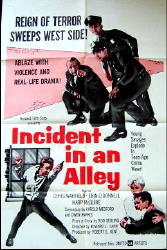
The earlier version of this nearly bottom-of-the-barrel movie, based on production values, appeared as the eleventh episode of the third season of the television series The United States Steel Hour, November 23rd, 1955. The author, Rod Serling, later became, of course, probably the best known writer for television there ever was, or ever will be.
Which means that the story value is above average – I won’t say high – in spite of some serious gaffes, but the sets the play is staged on are only one step above that of the original “Honeymooners” series, say, and pitiful indeed – never mind the fact that a key portion of the little action there is supposedly takes place outdoors. The TV roots are showing badly, in other words.
Chris Warfield plays a cop named Bill Joddy (pronounced “Jody”) in this one. After a theft of some musical instruments from a small store in a bad section of town, Joddy hears a woman scream after being knocked down, and he chases the assailant down an alley. After warning him to stop or he’ll shoot, the person fleeing doesn’t stop, Joddy shoots …
… and it turns out to be a small 13-year-old boy he has killed. A trial as well as a small courtroom morality play ensues. I won’t tell you the result of the trial, but in some ways it could have come out either way, as the story is not over, not for Joddy, and not for the gang of hoodlums who pulled the original robbery.
Erin O’Donnell, who plays Joddy’s wife, had a short career in TV and the movies. I hate to say not surprisingly, but there’s certainly no chemistry or rapport that I could discern between her and Chris Warfield in any of the scenes they had together. Which may not entirely be her fault. Warfield’s career took a nosedive into adult film-making in the late 60s through the 1970s, mostly as a producer and/or director.
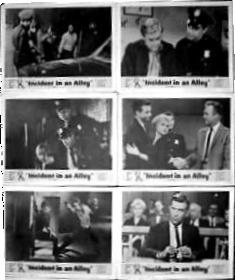
I’ve not been able to come up with proper photos of either O’Donnell or Warfield, only a set of lobby cards once offered on eBay, and I apologize that they’re too small to be of any value.
But if it helps at all, in the card in the lower right corner, that’s Warfield in a close-up taken during the trial. Above that, in the center right position, is a scene with Erin O’Donnell as Mrs. Joddy in her husband’s arms.
Only Virginia Christine, as the dead boy’s mother, and Willis Bouchey, as Joddy’s immediate superior in the police department, show much in the way of acting ability, and even they are hampered by the lack of any real depth to the tale.
Major errors, I believe – and if I’m wrong, please correct me – come in the courtroom scenes, which have the defense putting on their case first, the prosecution calling the defendant as one of their witnesses, and the judge in general allowing all kinds of extraneous testimony being allowed with the jury still in the room.
And from a detective story point of view, not until the jury’s verdict has been given is any real investigation made, and that is done by Joddy himself, the accused child killer.
Director Edward Cahn is a new name to me, but apparently not to movie fans who follow the careers of movie directors more closely than I have. He started in 1931, but not until 1955 did the most active part of his career begin, doing literally tons of bargain basement budgeted films of all kinds, but in large part SF movies like Creature with the Atom Brain (1955) and It! The Terror from Beyond Space (1958). Other crime movies he directed in this same time period are Hong Kong Confidential (1958) and Guns, Girls, and Gangsters (1959).
Overall, then, for Incident in an Alley? Interesting enough to watch all the way through, but if I’d been interrupted, I might not have gotten back to it right away.
[FOLLOW-UP.] Later the same day. Here are some of the results I’ve come up with after doing some Googling for information about Edward Cahn:
From Mike Grost’s website, an overview of some of Cahn’s directorial techniques:
http://members.aol.com/MG4273/cahn.htm
From the New York Times, a complete biography:
http://movies.nytimes.com/person/83815/Edward-L-Cahn/biography
From Fandango, an annotated list of many of his films:
http://www.fandango.com/edwardl.cahn/filmography/p83815
Mon 4 Aug 2008
It’s been a while since I’ve uploaded another page to the ongoing Addenda to Al Hubin’s Revised Crime Fiction IV, but Part 28 is up and running as of 10 minutes ago.
The first link will take you to the main page, where I’d recommend you go if you’re a first time visitor. The second link goes directly to the new material, to which I have not yet added any of my usual enhancements — links, cover images, and added biographical information — but which I will as time goes on.
There are no major pockets of interest, only a steady accumulation of new data, additions and corrections both. Part 29 will be along shortly, Al promises, as he’s been working on both Parts 28 and 29 more or less at the same time. And as usual, when it does appear, you’ll read about it here first!
Mon 4 Aug 2008
The time went by very quickly, as it always does. Paul Herman and I arrived in Dayton soon after 2 pm on Wednesday and he dropped me off at home yesterday around 5 pm. In between were many many hours of visiting with people I hadn’t seen since last year (except of course people I’d seen at the Windy City show only a few months before).
No matter. Being able to talk at length with with people with the same nutty (um, specialized) interests as you do is always a pleasure. That and a special nod to Randy Cox and Walter & Jim Albert, whom whom Paul and I spent a lot of time outside the convention center (meals and bookhunting) as well as inside, it seemed all too soon before it was over and it was time to leave.
Only the absence of my long-time friend Jim Goodrich, who was unexpectedly hospitalized the weekend before, took any luster off the proceedings. Get well soon, Jim!
While the dealers room was full of pulp magazines, I managed an all time low in the purchasing any, and in fact it’s a number that’s impossible to surpass: none (after buying only one last year). The selection was fine, but as I perhaps explained earlier, my funds were low. Attendance was also low, but (in my opinion) not dangerously so, as the enthusiasm around the room seemed high.
What I did obtain consisted largely of various reprints of pulp stories and novels in trade paperback. Print-on-demand is getting easier and easier to do all the time, and the results, more often than not, are very impressive.
Without intending to slight other publishers whose efforts I intend to review and talk about later, as time goes on, here are two such examples:
From Age of Aces Press: A flip book with two early mystery novels by Steve Fisher: Murder of the Admiral (Macauley, 1936, as by Stephen Gould) and Murder of the Pigboat Skipper (Hillman-Curl, 1937). Both are cases for a chief detective for U.S. Naval Intelligence named Lieutenant Commander Sheridan Doome. (Follow the link for more information.)
Age of Aces Press specializes in air fiction stories that largely take place during World War I and soon thereafter, but I’m told that if there’s a military connection, they’d be interested in reprinting any kind of vintage detective or spy fiction as well. If you have any suggestions along these lines, I’d certainly be happy to pass them along to editor Bill Mann and art director Chris Kalb.
From Black Dog Books: Dead Men Tell Tales, by Arthur B. Reeve, a collection of stories about Craig Kennedy, a scientific detective who was on the job long before either Patricia Cornwell or CSI came along.
Much of Black Dog’s output consists of tales of high adventure, a la Talbot Mundy — whose body of work not so coincidentally they’ll be reprinting in total over the next few months, they being Tom Roberts and Gene Christie.
Tom, by the way, and not so incidentally, was awarded this year’s Lamont award for his outstanding contributions to the hobby of pulp collecting. Another very popular choice!
Guest of honor was SF writer Larry Niven, who never wrote for the pulps, since he began his career in the mid-1960s for the digest magazines, but whose work has always had (to me) the same sense of wonder the the SF in the pulp era had (and so seldom seems to have today). I had a short opportunity to talk to him, talking about mathematics, a field which we have in common, as well as his days writing for If, Galaxy and Worlds of Tomorrow. A fine gentleman.
Back to pulps for a moment, if I may. Ed Kessell, a long time pulp fan and the one who put on the very first Pulpcon, back in 1972, died earlier this year. His sons brought a good portion of his collection to sell at their table and to put up for auction. Their table, before the doors were opened and sales could begin, was a sight to behold: stacks and stacks of rare and obscure pulps like Thrilling Adventure, All Star Detective, Clues, Dime Detective and many more. I wish I’d had a camera. They sold very quickly.
The cream of the cream was reserved for the first night’s auction, however: a scattered run of Far East Adventure Stories which sold individually for quite remarkable prices, but not to me.
Ah yes, the stuff dreams are made of.
« Previous Page




